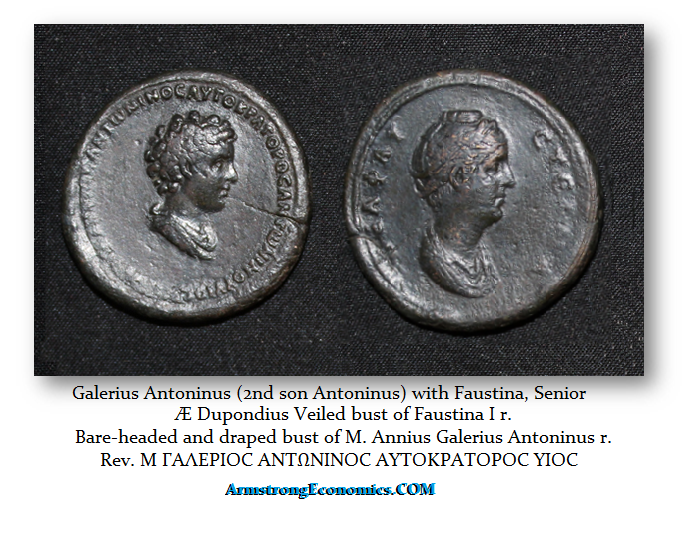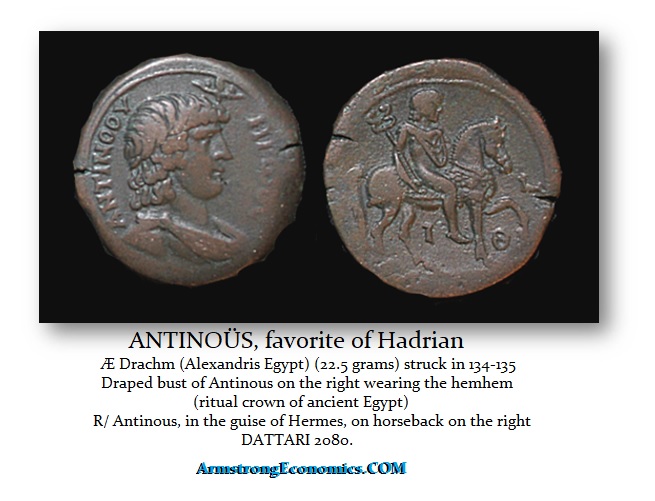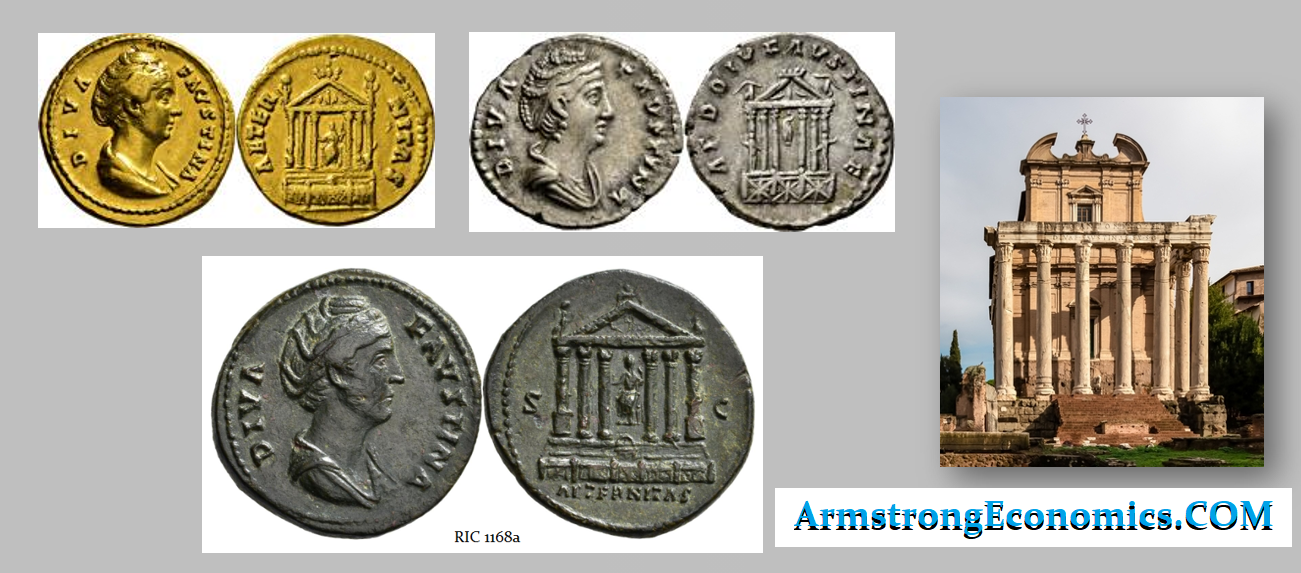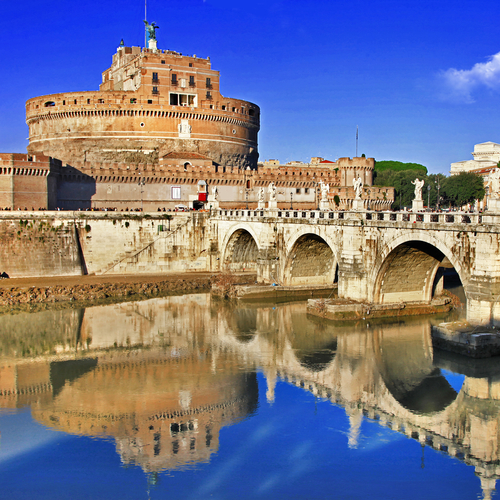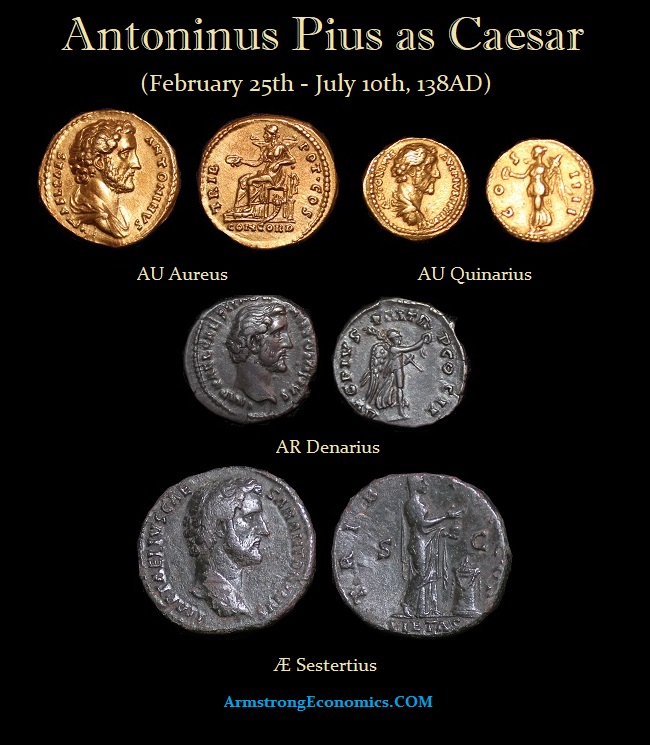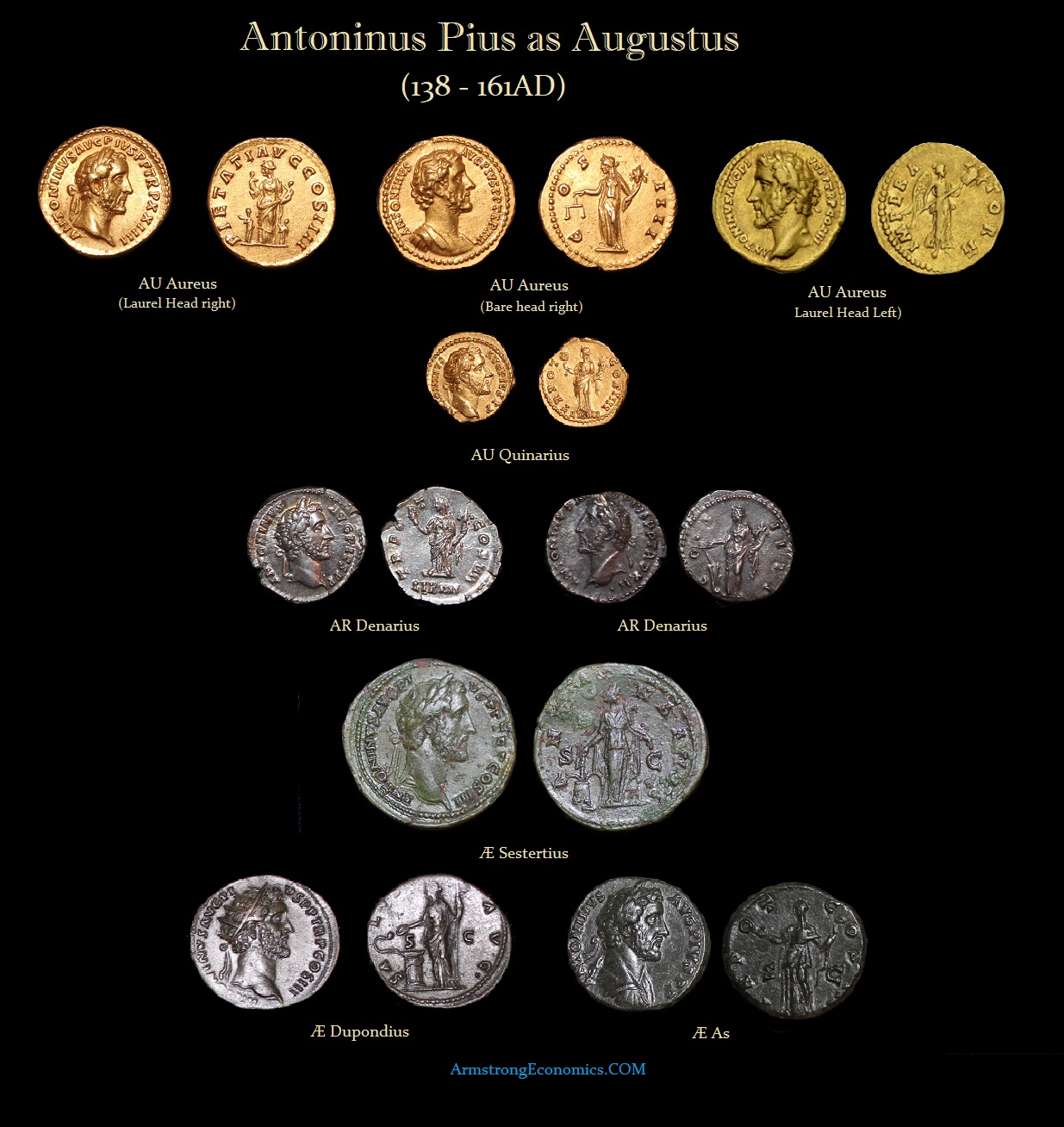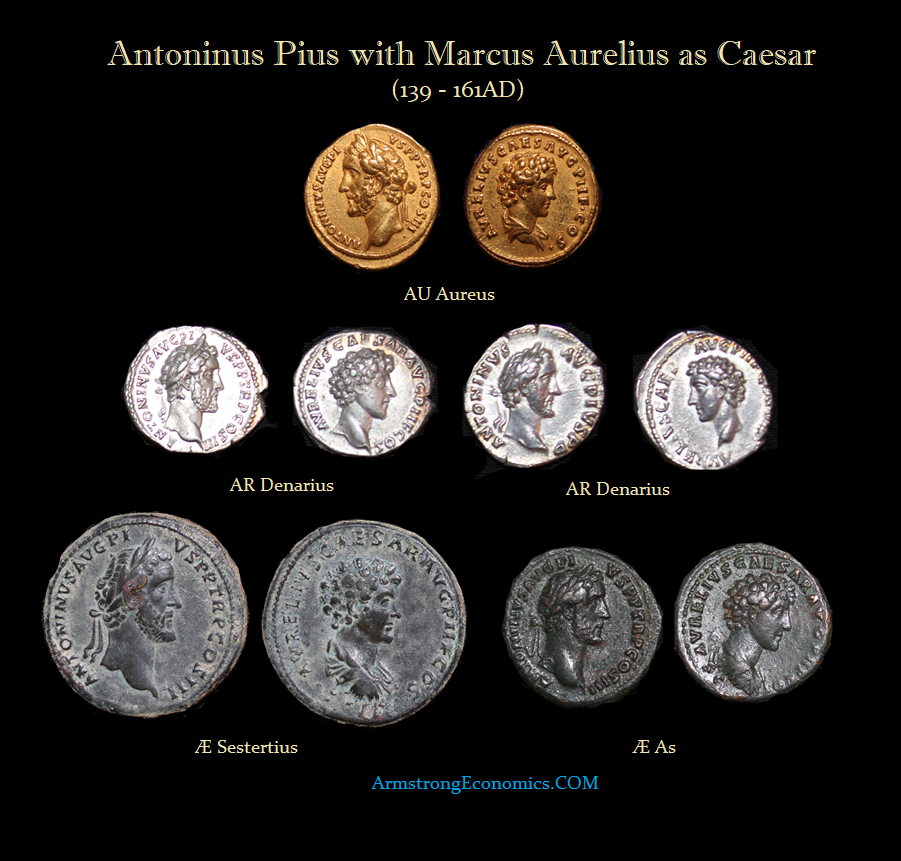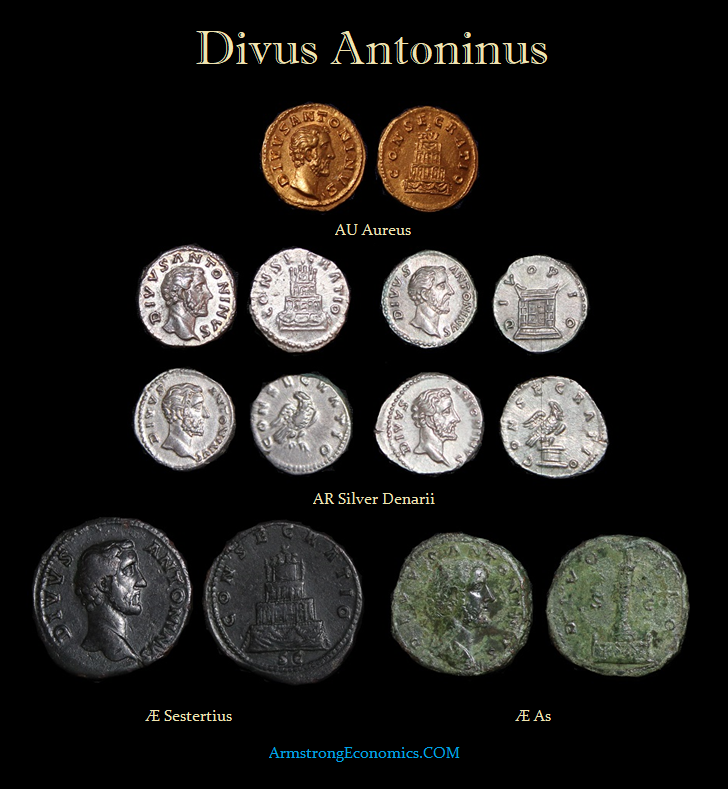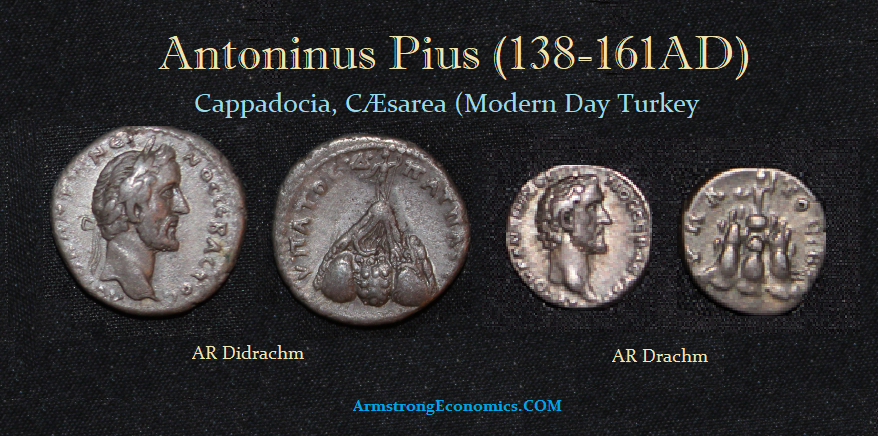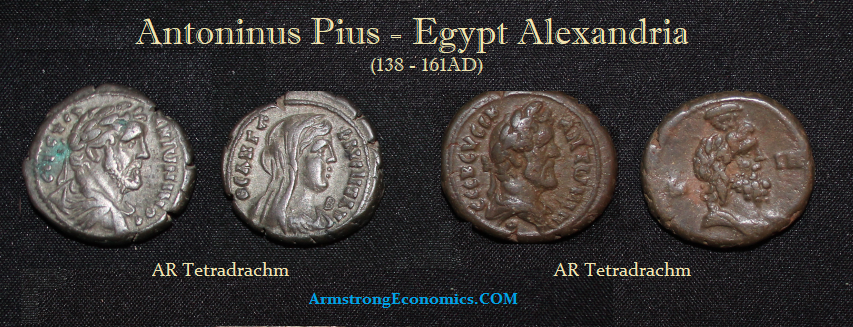Antoninus Pius
138 – 161 AD
Born 86 – Died 161 AD, Age 75
Titus Aurelius Fulvua Boionius Arrius Antoninus, known to history as Antoninus Pius, was born of a good family in Nimes in the Gallia Narbonensis region (Southern France). Several members of his family had served as consuls of Rome, which enabled him to serve as Quaestor and Praetor before becoming Vir Consularis, a judicial appointment in Umbria and Etruria.
Antoninus served as Consul in 120 AD. Sometime around 133-136 AD, Antoninus served as Proconsul of Asia. At this time, he first came to the attention of Emperor Hadrian, who was impressed enough with his abilities that he appointed him to his Conilium Principis (royal counsel).
Antoninus married Faustina before his adoption by Hadrian and bore four children during her marriage – two sons and two daughters. Their two sons and one daughter died before Antoninius’ adoption, leaving one surviving daughter, Faustina, Junior.
Antoninus’ Children
Marcus Aurelius Fulvus Antoninus (died before 138); his sepulchral inscription is in Hadrian’s Mausoleum.
Marcus Galerius Aurelius Antoninus (died before 138); his sepulchral inscription is in Hadrian’s Mausoleum but is also remembered in the coinage.
Aurelia Fadilla (died in 135) married Lucius Plautius Lamia Silvanus, consul 145, but had no children.
Annia Galeria Faustina Minor or Faustina the Younger (between 125 and 130–175) married her maternal cousin Marcus Aurelius in 146.
Following the death of Aelius Caesar, Hadrian needed an heir who was both able and childless at this point in time. Antoninus was that man. Hadrian adopted Antoninus on February 25th, 138, one month after the death of Aelius Caesar. During the last months of Hadrian’s reign, Antoninus assumed the role of a virtual ruler of the Roman Empire. His succession on July 10th, following Hadrian’s death, was smooth.
At the time of Antoninus’ adoption, Hadrian had included a clause whereby Antoninus, in turn, adopted the young Marcus Aurelius, whom Hadrian took special care to ensure his brilliant education.
Antoninus began his reign by refusing to execute a group of men whom the Senate had marked on a list for various reasons. He shocked the Senate by responding, “I must not begin my reign with such actions.” Antoninus also conducted an extended mourning period and insisted upon the Senate’s approval to deify Hadrian despite some resistance due to his homosexual behavior with his male lover – Antinous. For these acts, Antoninus was given the name “Pius.”
The reign of Antoninus Pius was a period of peace and calm. So much so that his reign left little record in history. Antoninus was a good administrator, and this is where he focused his attention, thus creating an era of prosperity. He did not show any tendency for glory or to expand the Empire for posterity. Instead, he is best remembered for being patient, judicious, and impartial. Antoninus was also very tolerant of various religions, including the Christians.
Antoninus also instituted several regulatory reforms and restored powers to the Senate without relinquishing any imperial powers that would weaken his office. The Senate gained some administrative authority, while Antoninus also focused on building projects throughout Italy. It is entirely probable that he never left Italy during his reign.
In 140 AD, Faustina, his wife, died. This event genuinely shook Antoninus. He consecrated her in 141 AD and issued one of Roman history’s largest commemorative series of coinage. He also built the Temple of Faustina in the Forum, which is still seen today.
In areas of foreign policy, Antoninus did not neglect the frontiers. He completed the construction of Hadrian’s Wall across Britain in 141 AD. He sought to maintain the defenses of the Empire on all fronts. He also created an Armenian Kingdom to boost the defenses against Parthia.
Antoninus died at Lorium on March 7th, 161 AD. His adopted son, Marcus Aurelius, succeeded him as intended by Hadrian’s will. His body was cremated, and his ashes were placed at rest in Hadrian’s mausoleum, which today is Castle St Angelo. Following his death, a series of commemorative coins were struck in his honor – the largest such issue since the death of Augustus.

Column of Antoninus Pius
A spectacular column was also erected. Unfortunately, all that remains is it currently on display in Hadrian’s mausoleum. Marcus Aurelius married Antonius’s daughter Faustina, Junior, in 145 AD. Initially, Marcus had been married to the daughter of Aelius Caesar.
Titles and Powers, 138-161 AD
Yr Tribunician Power Imperatorial Consul Other
138 TR.P. COS.DES.II. CAESAR. later,
138 IMP. AVGVSTVS. P.M. PIVS.
139 TR.P. TR.P.II COS.II DES.III. P.P.
140 TR.P.II. III. COS.III.
141 TR.P.III. – IIII.
142 TR.P.IIII. – V.
143 TR.P.V. – VI. IMP.II.
144 TR.P.VI. – VII. COS.DES.IIII.
145 TR.P.VII. – VIII. COS.IIII.
146 TR.P.VIII. – VIII.
147 TR.P.VIIII. – X. – XI.
148 TR.P.XI. – XII.
149 TR.P.XII. – XIII.
150 TR.P.XIII. – XIIII.
151 TR.P.XIIII – XV.
152 TR.P.XV. – XVI.
153 TR.P.XVI. – XVII.
154 TR.P.XVII. – XVIII.
155 TR.P.XVIII. – XVIII~.
156 TR.P.XVIIII. – XX.
157 TR.P.XX. – XXI.
158 TR.P.XXI. – XXII.
159 TR.P.XXII. – XXIII.
160 TR.P.XXIII. – XXIIII.
161 TR.P.XXIIII.
Antoninus received the tribunician power on February 25th, 138 AD. The tribunician power was subsequently renewed each year on that date until 147 AD when it was renewed again on December 10th, which subsequently became the normal date for all future renewals His first consulship was in 120 AD.
Monetary System

Mint: Rome
As Caesar
February 25th-July 10th, 138 AD, under Hadrian
As Augustus
Obverse Legends:
ANTONINVS AVG PIVS P P
ANTONINVS AVG PIVS P P IMP II
ANTONINVS AVG PIVS P P TR P
ANTONINVS AVG PIVS P P TR P XI (-XXIIII).
ANTONINVS AVG PIVS P P TR P COS III
IMP CAES T AEL HADR ANTONINVS AVG PIVS P P
DENOMINATIONS
As Caesar (February 25th – July 10th, 138AD)
AU Aureus (6.54 grams)
AU Quninarius (3.14 grams)
AR Denarius (3.54 grams)
AE Sestertius
AE As
As Augustus (138-161AD)
AU Aureus (6.54 grams)
AU Quninarius (3.14 grams)
AR Denarius (3.54 grams)
AR Quinarius
AE Sestertius
AE Dupondius
AE As
AE Quadrans
Antoninus Pius with Marcus Aurelius as Caesar
AU Aureus (Laur hd left/Bare hd rt)
AR Denarius (Head right/Head Left)
AR Denarius (Head right/Head right)
Æ Sestertius
Æ Dupondius
Æ As
DIVUS Antoninus
AU Aureus (Bare hd rt DIVVS ANTONINVS/Funeral Pyre)
AR Denarius [divvs antoninus Bare hd rt/Eagle stg]
AR Denarius [divvs antoninus Bare hd rt/Eagle stg on altar]
AR Denarius [divvs antoninus Bare hd rt/Eagle stg on globe]
AR Denarius [divvs antoninus Bare hd rt/Funeral Pyre]
AR Denarius [Bare hd rt/DIVO PIO Column statue Ant]
AR Denarius [Bare hd rt/DIVO PIO Square Altar]
AR Denarius [Bare hd rt/DIVO PIO Seated lf brach sceptre]
Æ Sestertius (Funeral Pyre)
Æ Sestertius (Funeral Pyre)
Æ Sestertius (Altar)
Æ Sestertius (Laur hd left/Eagle on Globe)
Æ Sestertius (Laur hd rt/Eagle on Globe)
Æ Sestertius (Bare hd rt/CONSECRATIO – S – C Eagle flies r., thunderbolt in claws)
Æ Sestertius(Bare hd rt/Statue on column)
Æ Sestertius (Column of Antoninus)
Æ As
COLONIAL
CAESAREA
AR Drachm (CÆsarea)
AR Didrachm (CÆsarea)
EGYPT
AR Tetradrachm (Egypt, Alexandria)
AR Tetradrachm (with his wife veiled)


